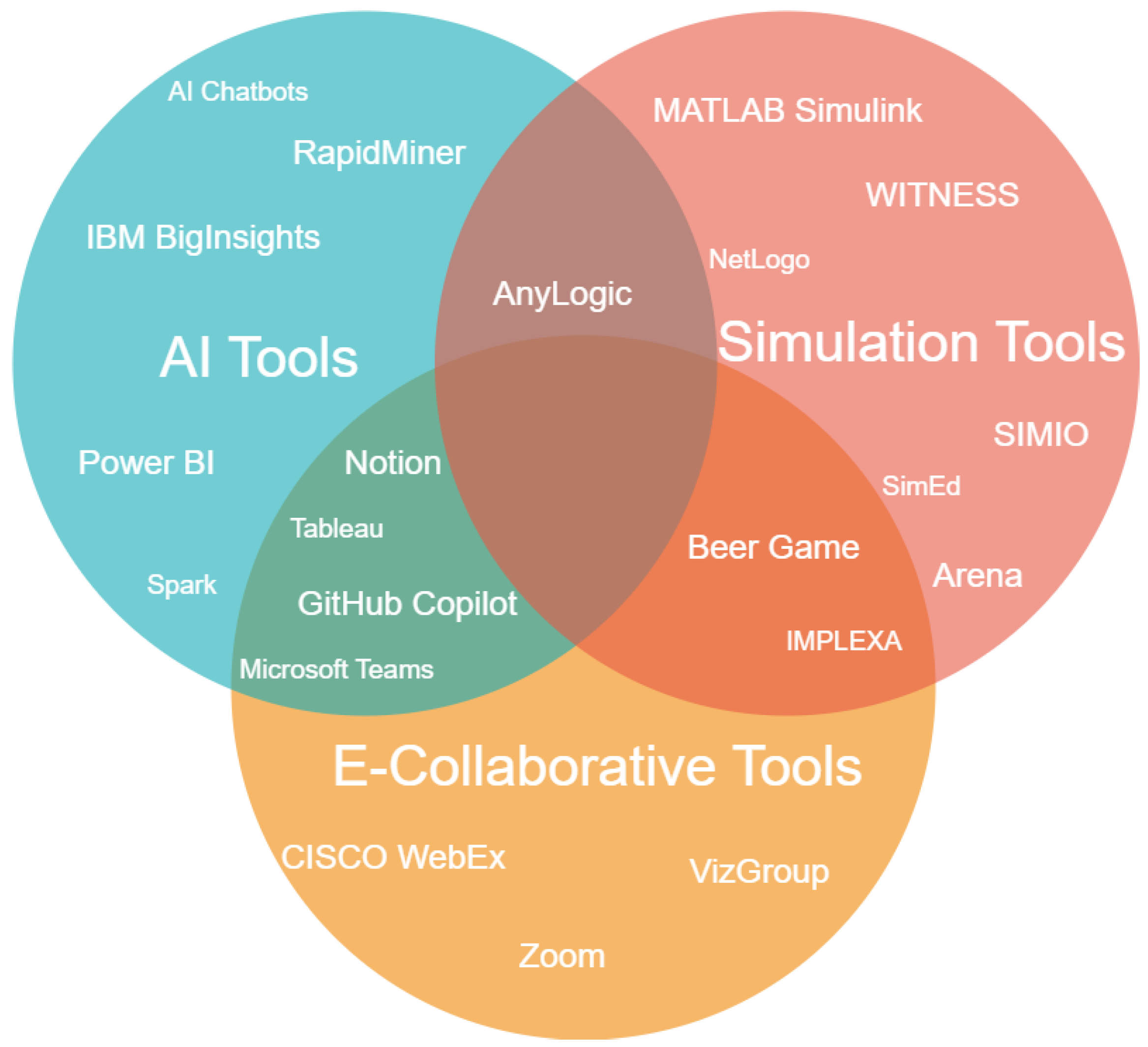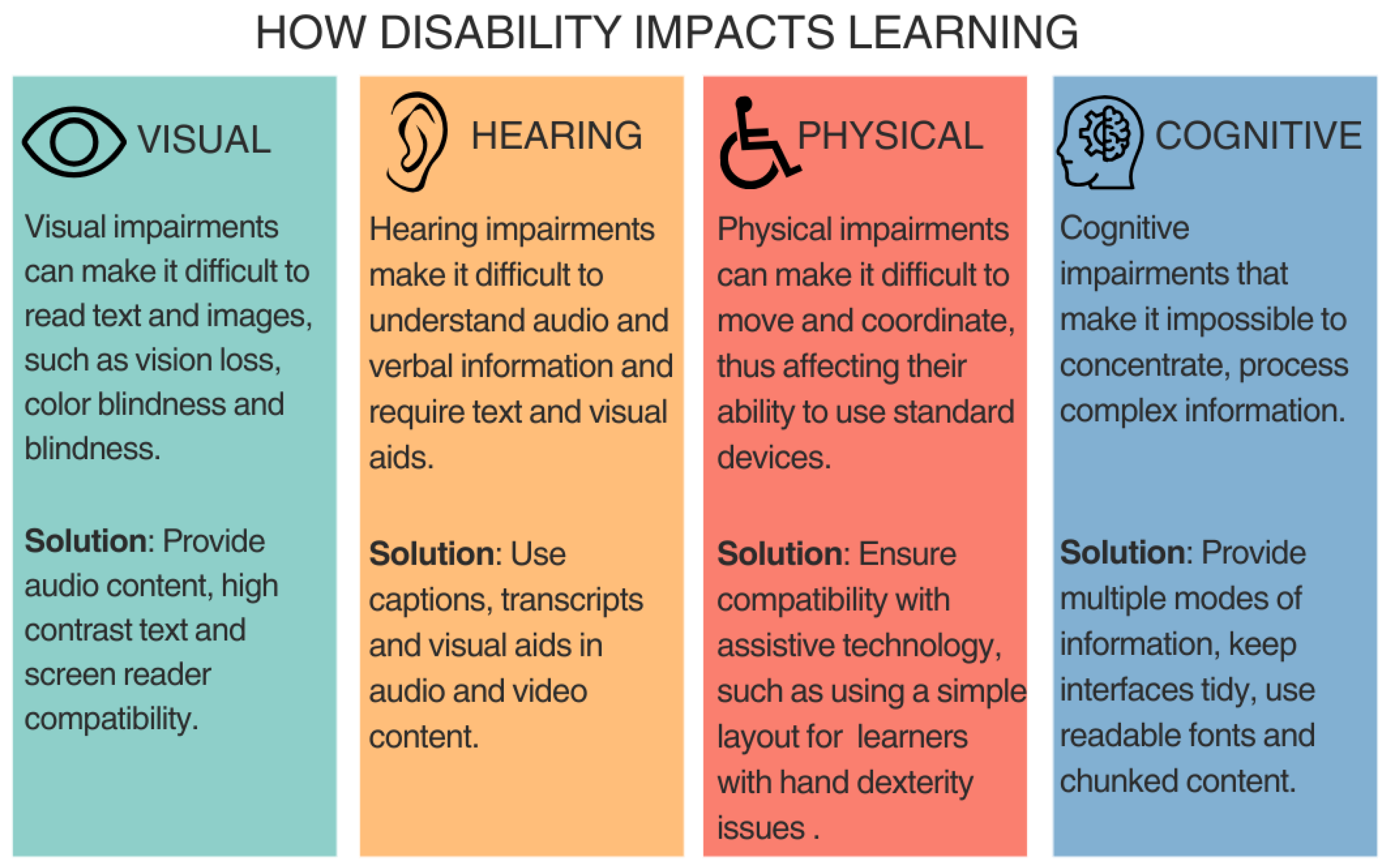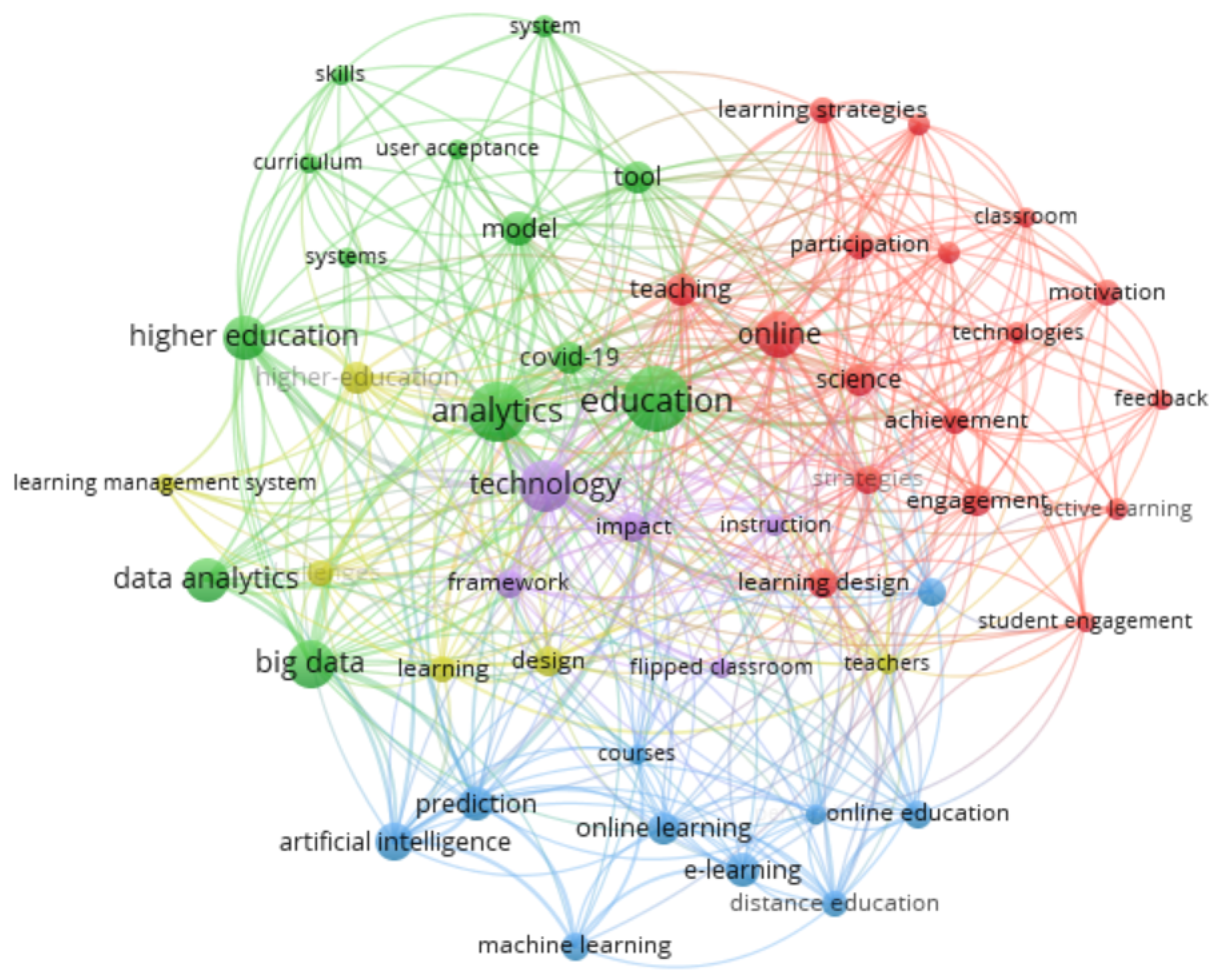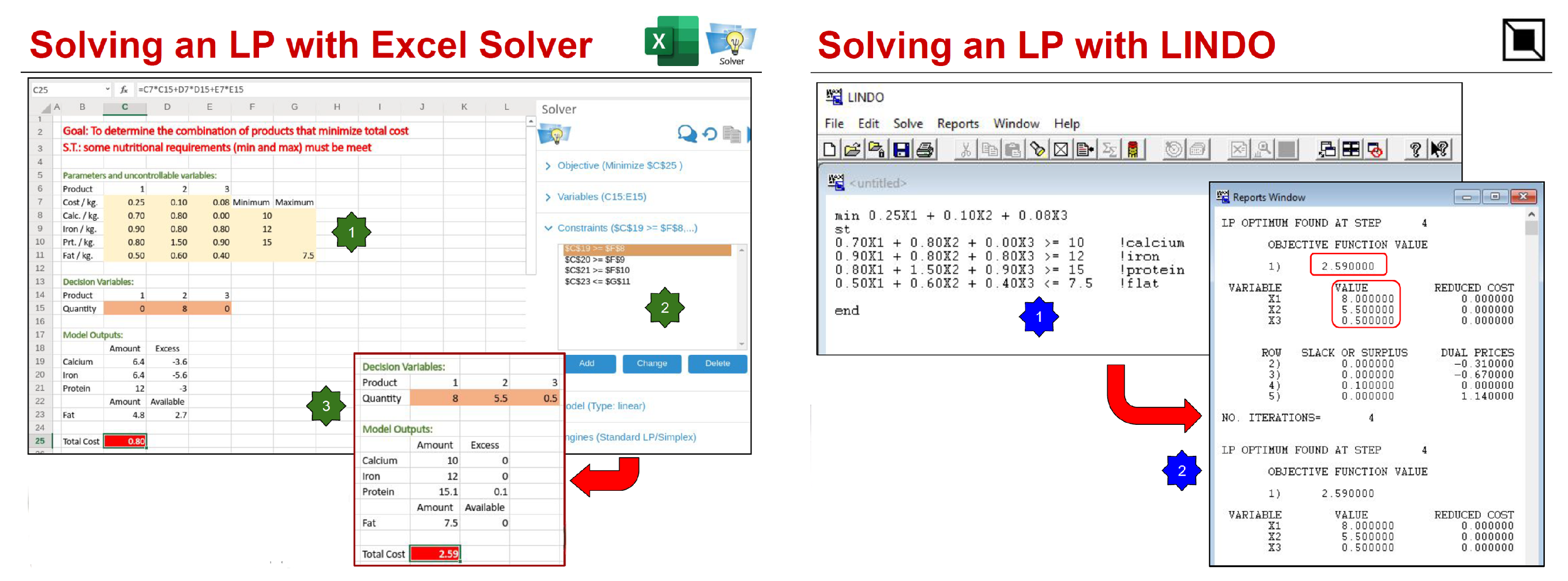Enhancing Accessibility to Analytics Courses in Higher Education through AI, Simulation, and e-Collaborative Tools
Abstract
:1. Introduction
2. Methodology
3. Literature Review
3.1. The Role of Accessibility in Education
- Language barriers: One of the primary challenges faced by students from non-native language backgrounds is language barriers to comprehension and expression. These students often struggle to keep pace with their peers in understanding instructional materials and participating in classroom discussions. To address this issue, research advocates for the implementation of language support services, such as ESL (English as a Second Language) programs, which can provide tailored assistance to help these students develop proficiency in the language of instruction [7].
- Previous educational quality: The variability in the quality of prior education can result in significant gaps in foundational knowledge and skills among students. The student demographics in online education have changed, with of online learners being over the age of 30 [8]. Those who have experienced subpar educational settings may struggle to meet the academic demands of their new environments [9]. To improve the accessibility of education, AI technology is widely used to help students improve teaching effectiveness and learning experience. Diagnostic assessments [10] can help identify these gaps early on, allowing educators to develop personalized learning plans tailored to each student’s needs.
- Learning disabilities and special needs: Students with learning disabilities or special needs require specific accommodations and tailored instructional methods to succeed academically. These students face unique challenges that standard educational practices may not adequately address [11]. The impact of the four most common disabilities on learning and the common solutions are illustrated in Figure 2.
- Cultural differences: Students from diverse cultural backgrounds may find it challenging to fulfill the social and academic expectations of their new settings [12]. Culturally responsive teaching practices, which include incorporating diverse cultural perspectives into the curriculum and promoting an inclusive school culture, can help mitigate these issues. By valuing and respecting cultural diversity, educators can create a more welcoming and supportive environment for all students. This view aligns with the role of open educational resources (OERs) in promoting inclusive learning. Hockings et al. [13] highlighted that OERs provide flexible and accessible learning materials that cater to diverse student needs.
- Socioeconomic disparities: The uneven distribution of resources is a serious impediment to the accessibility of education. In Norway and Switzerland, of students are fortunate enough to have access to electronic devices, whereas in Indonesia, only of students have such access [14]. Students without available resources face a host of socioeconomic challenges that affect their educational experiences. These students often lack access to essential resources such as technology, learning materials, and extracurricular opportunities, which are crucial for holistic development [15]. To combat these disparities, schools can implement financial aid programs that alleviate the economic burden on families. Providing free or low-cost learning materials and creating supportive environments where all students have equal access to educational resources can significantly enhance the learning outcomes for socioeconomically disadvantaged students.
3.2. The Use of Technology in Teaching Analytical Courses
4. AISEC Tools for Teaching Analytical Courses
4.1. AI Tools for Teaching Analytical Courses
4.1.1. Various AI Tools Used for Teaching Analytics
4.1.2. AI-Based Language Support Tools for Non-Native Speakers
4.2. Simulation Tools for Teaching Analytical Courses
4.2.1. Discussion of How Simulation Software Enhances Experiential Learning
4.2.2. Examples of Simulation-Based Exercises for Teaching Statistical and Analytical Concepts
4.3. The Use of e-Collaborative Tools for Teaching Analytical Courses
4.3.1. Discussion of Virtual Collaboration Platforms for Group Projects
4.3.2. Exploration of Accessibility Features in Platforms like Teams and Google Meet
5. Experiences at Universitat Politècnica de València
5.1. Fishbanks: A Simulation for Sustainable Resource Management
5.2. Markstrat: A Simulation for Marketing Management
5.3. Gestionet: A Finance Simulation for Financial Management
5.4. Implexa: An Evolutive Beer Game Simulation for Logistics
5.5. LLOG VR: Virtual Reality for Logistics
5.6. Discussion on Accessibility and Usability in UPV
6. Experiences at University College Dublin
6.1. Turnitin and ChatGPT: AI Tools for Assisting Search
6.2. Solver and LINDO Simulation Tools for Optimization and Analytics
6.3. Ft.Com: A Stock Trading Simulation for Technology Consulting
6.4. Discussion on Accessibility and Usability in UCD
7. Experiences at Universidade Aberta
7.1. Simulation for Decision-Making Optimization
7.2. Open Class Initiative
7.3. Discussion on Accessibility and Usability at Universidade Aberta
8. Conclusions
Author Contributions
Funding
Institutional Review Board Statement
Informed Consent Statement
Data Availability Statement
Conflicts of Interest
References
- Campos, N.; Corlu, C.G.; Nogal, M.; Juan, A.A.; Caliz, C. Simulation-based mathematical learning for higher education students from heterogeneous backgrounds. J. Simul. 2024, 18, 477–488. [Google Scholar] [CrossRef]
- Zawacki-Richter, O.; Marín, V.I.; Bond, M.; Gouverneur, F. Systematic review of research on artificial intelligence applications in higher education—Where are the educators? Int. J. Educ. Technol. High. Educ. 2019, 16, 39. [Google Scholar] [CrossRef]
- Kübler, A.; Holz, E.M.; Sellers, E.W.; Vaughan, T.M. Toward independent home use of brain-computer interfaces: A decision algorithm for selection of potential end-users. Arch. Phys. Med. Rehabil. 2015, 96, S27–S32. [Google Scholar] [CrossRef] [PubMed]
- Andrews, S.; Bare, L.; Bentley, P.; Goedegebuure, L.; Pugsley, C.; Rance, B. Contingent Academic Employment in Australian Universities; LH Martin Institut: Parkville, Australia, 2016; p. 19. [Google Scholar]
- Burgstahler, S.E.; Cory, R.C. Universal Design in Higher Education: From Principles to Practice; Harvard Education Press: Cambridge, MA, USA, 2010. [Google Scholar]
- Means, B.; Toyama, Y.; Murphy, R.; Baki, M. The effectiveness of online and blended learning: A meta-analysis of the empirical literature. Teach. Coll. Rec. 2013, 115, 1–47. [Google Scholar] [CrossRef]
- Crawford, T.; Candlin, S. A literature review of the language needs of nursing students who have English as a second/other language and the effectiveness of English language support programmes. Nurse Educ. Pract. 2013, 13, 181–185. [Google Scholar] [CrossRef] [PubMed]
- Rungta, K. 100+ must know online learning statistics in 2022. Retrieved Oct. 2022, 25, 2022. [Google Scholar]
- García, E.; Weiss, E. Education Inequalities at the School Starting Gate: Gaps, Trends, and Strategies to Address Them; Economic Policy Institute: Washington, DC, USA, 2017. [Google Scholar]
- Sun, Y.; Suzuki, M. Diagnostic assessment for improving teaching practice. Int. J. Inf. Educ. Technol. 2013, 3, 607. [Google Scholar] [CrossRef]
- Coleman, M.; Berge, Z. A review of accessibility in online higher education. Online J. Distance Learn. Adm. 2018, 21, 1–7. [Google Scholar]
- Banks, J.A. Cultural Diversity and Education: Foundations, Curriculum, and Teaching; Routledge: London, UK, 2015. [Google Scholar]
- Hockings, C.; Brett, P.; Terentjevs, M. Making a difference—Inclusive learning and teaching in higher education through open educational resources. Distance Educ. 2012, 33, 237–252. [Google Scholar] [CrossRef]
- Palvia, S.; Aeron, P.; Gupta, P.; Mahapatra, D.; Parida, R.; Rosner, R.; Sindhi, S. Online education: Worldwide status, challenges, trends, and implications. J. Glob. Inf. Technol. Manag. 2018, 21, 233–241. [Google Scholar] [CrossRef]
- Vigevano, L.; Mattei, P. The challenges of distance learning in Italy: New inequalities and implications for inclusive education. Int. J. Incl. Educ. 2023, 1–15. [Google Scholar] [CrossRef]
- Jeyaraj, A. Pedagogy for business analytics courses. J. Inf. Syst. Educ. 2019, 30, 67. [Google Scholar]
- Vittorini, P.; Menini, S.; Tonelli, S. An AI-based system for formative and summative assessment in data science courses. Int. J. Artif. Intell. Educ. 2021, 31, 159–185. [Google Scholar] [CrossRef]
- Liebowitz, J. Data Analytics and AI; CRC Press: Boca Raton, FL, USA, 2020. [Google Scholar]
- Rabia, M.A.B.; Bellabdaoui, A. Simulation-based analytics: A systematic literature review. Simul. Model. Pract. Theory 2022, 117, 102511. [Google Scholar] [CrossRef]
- Alharbi, S.M.; Elfeky, A.I.; Ahmed, E.S. The effect of e-collaborative learning environment on development of critical thinking and higher order thinking skills. J. Posit. Sch. Psychol. 2022, 6, 6848–6854. [Google Scholar]
- Alam, A. Should robots replace teachers? Mobilisation of AI and learning analytics in education. In Proceedings of the 2021 International Conference on Advances in Computing, Communication, and Control (ICAC3), Mumbai, India, 3–4 December 2021; pp. 1–12. [Google Scholar]
- Salas-Pilco, S.Z.; Xiao, K.; Hu, X. Artificial intelligence and learning analytics in teacher education: A systematic review. Educ. Sci. 2022, 12, 569. [Google Scholar] [CrossRef]
- Asamoah, D.A.; Sharda, R.; Hassan Zadeh, A.; Kalgotra, P. Preparing a data scientist: A pedagogic experience in designing a big data analytics course. Decis. Sci. J. Innov. Educ. 2017, 15, 161–190. [Google Scholar] [CrossRef]
- Eckroth, J. A course on big data analytics. J. Parallel Distrib. Comput. 2018, 118, 166–176. [Google Scholar] [CrossRef]
- Allil, K. Integrating AI-driven marketing analytics techniques into the classroom: Pedagogical strategies for enhancing student engagement and future business success. J. Mark. Anal. 2024, 12, 142–168. [Google Scholar] [CrossRef]
- Ng, C. Teaching Advanced Data Analytics, Robotic Process Automation, and Artificial Intelligence in a Graduate Accounting Program. J. Emerg. Technol. Account. 2023, 20, 223–243. [Google Scholar] [CrossRef]
- Maher, M.L.; Tadimalla, S.Y.; Dhamani, D. An Exploratory Study on the Impact of AI tools on the Student Experience in Programming Courses: An Intersectional Analysis Approach. In Proceedings of the 2023 IEEE Frontiers in Education Conference (FIE), College Station, TX, USA, 18–21 October 2023; pp. 1–5. [Google Scholar]
- González-Carrillo, C.D.; Restrepo-Calle, F.; Ramírez-Echeverry, J.J.; González, F.A. Automatic grading tool for jupyter notebooks in artificial intelligence courses. Sustainability 2021, 13, 12050. [Google Scholar] [CrossRef]
- Moloney, R.; Saltmarsh, D. ’Knowing your students’ in the culturally and linguistically diverse classroom. Aust. J. Teach. Educ. (Online) 2016, 41, 79–93. [Google Scholar] [CrossRef]
- Guo, P.J.; Reinecke, K. Demographic differences in how students navigate through MOOCs. In Proceedings of the First ACM Conference on Learning@ Scale Conference, Atlanta, GA, USA, 4–5 March 2014; pp. 21–30. [Google Scholar]
- Tomlinson, C.A. The Differentiated Classroom: Responding to the Needs of All Learners; ASCD: Alexandria, VA, USA, 2014. [Google Scholar]
- Fitria, T.N. Artificial Intelligence (AI) in Education: Using AI Tools for Teaching and Learning Process. In Proceedings of the Prosiding Seminar Nasional & Call for Paper STIE AAS, Surakarta, Jawa Tengah, 2021; pp. 134–147. Available online: https://www.researchgate.net/publication/357447234_Artificial_Intelligence_AI_In_Education_Using_AI_Tools_for_Teaching_and_Learning_Process (accessed on 1 June 2024).
- Chen, Y.; Jensen, S.; Albert, L.J.; Gupta, S.; Lee, T. Artificial intelligence (AI) student assistants in the classroom: Designing chatbots to support student success. Inf. Syst. Front. 2023, 25, 161–182. [Google Scholar] [CrossRef]
- Mageira, K.; Pittou, D.; Papasalouros, A.; Kotis, K.; Zangogianni, P.; Daradoumis, A. Educational AI chatbots for content and language integrated learning. Appl. Sci. 2022, 12, 3239. [Google Scholar] [CrossRef]
- Jordan, M.; Ly, K.; Soosai Raj, A.G. Need a Programming Exercise Generated in Your Native Language? ChatGPT’s Got Your Back: Automatic Generation of Non-English Programming Exercises Using OpenAI GPT-3.5. In Proceedings of the 55th ACM Technical Symposium on Computer Science Education V. 1, Portland, OR, USA, 20–23 March 2024; pp. 618–624. [Google Scholar]
- Gonda, D.E.; Chu, B. Chatbot as a learning resource? Creating conversational bots as a supplement for teaching assistant training course. In Proceedings of the 2019 IEEE International Conference on Engineering, Technology and Education (TALE), Yogyakarta, Indonesia, 10–13 December 2019; pp. 1–5. [Google Scholar]
- McHaney, R. Simulation education in non-simulation courses. In Proceedings of the 2018 Winter Simulation Conference (WSC), Gothenburg, Sweden, 9–12 December 2018; pp. 4038–4045. [Google Scholar]
- Tvrdoň, L.; Jurásková, K. Teaching simulation in logistics by using witness and captivate software. Procedia-Soc. Behav. Sci. 2015, 174, 4083–4089. [Google Scholar] [CrossRef]
- Jackson, G.C.; Taylor, J.C. Administering the MIT Beer Game: Lessons learned. In Proceedings of the Developments in Business Simulation and Experiential Learning: Proceedings of the Annual ABSEL Conference, 1998; Volume 25. Available online: https://absel-ojs-ttu.tdl.org/absel/article/view/1049 (accessed on 1 June 2024).
- Lawson, B.; Leemis, L.M. Structuring a simulation course around the simEd package for R. In Proceedings of the 2021 Winter Simulation Conference (WSC), Phoenix, AZ, USA, 12–15 December 2021; pp. 1–12. [Google Scholar]
- Doddavaram, R.; Corlu, C.G. Teaching risk analytics using R. In Proceedings of the 2020 Winter Simulation Conference (WSC), Orlando, FL, USA, 14–18 December 2020; pp. 3272–3281. [Google Scholar]
- Perkins, K.; Adams, W.; Dubson, M.; Finkelstein, N.; Reid, S.; Wieman, C.; LeMaster, R. PhET: Interactive simulations for teaching and learning physics. Phys. Teach. 2006, 44, 18–23. [Google Scholar] [CrossRef]
- Sandita, A.V.; Popirlan, C.I. Developing a multi-agent system in JADE for Information management in educational competence domains. Procedia Econ. Financ. 2015, 23, 478–486. [Google Scholar] [CrossRef]
- Pires, V.F.; Silva, J.F.A. Teaching nonlinear modeling, simulation, and control of electronic power converters using MATLAB/SIMULINK. IEEE Trans. Educ. 2002, 45, 253–261. [Google Scholar] [CrossRef]
- Bernát, P. Modelling and simulation in education and the NetLogo simulation environment. Teach. Math. Comput. Sci. 2014, 12, 229–240. [Google Scholar] [CrossRef]
- Yalin, C.; Xiaofang, Q.; Cancan, J.; Yao, Z.; Qifei, H. Optimization Management System Simulation Teaching by Task-Driven. In Proceedings of the 2021 2nd International Conference on Mental Health and Humanities Education (ICMHHE 2021), Qingdao, China, 28–30 May 2021; Atlantis Press: Amsterdam, The Netherlands, 2021; pp. 315–318. [Google Scholar]
- Chwif, L.; Pereira, W. Simulation Teaching During the Pandemic: Report of an Experience in a Higher Education Private Institution. In Proceedings of the 2022 Winter Simulation Conference (WSC), Singapore, 11–14 December 2022; pp. 1–11. [Google Scholar]
- Barba-Guaman, L.R.; Quezada-Sarmiento, P.A.; Calderon-Cordova, C.A.; Sarmiento-Ochoa, A.M.; Enciso, L.; Luna-Briceno, T.S.; Conde-Zhingre, L.E. Using wolfram software to improve reading comprehension in mathematics for software engineering students. In Proceedings of the 2018 13th Iberian Conference on Information Systems and Technologies (CISTI), Caceres, Spain, 13–16 June 2018; pp. 1–4. [Google Scholar]
- Velázquez-Iturbide, J.Á.; Debdi, O.; Paredes-Velasco, M. A review of teaching and learning through practice of optimization algorithms. In Innovative Teaching Strategies and New Learning Paradigms in Computer Programming; IGI Global: Hershey, PA, USA, 2015; pp. 65–87. [Google Scholar]
- Akundi, A.; Edinbarough, I. Text Mining-Based Qualitative Student Assessment of Interactive Simulation Learning Using SIMIO Tool—A Work in Progress. Edinburg, USA, 2020. Available online: https://scholarworks.utrgv.edu/mie_fac/2/ (accessed on 19 June 2024).
- Chernikova, O.; Heitzmann, N.; Stadler, M.; Holzberger, D.; Seidel, T.; Fischer, F. Simulation-based learning in higher education: A meta-analysis. Rev. Educ. Res. 2020, 90, 499–541. [Google Scholar] [CrossRef]
- Pirker, J.; Gütl, C. Educational gamified science simulations. In Gamification in Education and Business; Springer: Cham, Switzerland, 2015; pp. 253–275. [Google Scholar]
- Majgaard, G.; Weitze, C. Virtual experiential learning, learning design and interaction in extended reality simulations. In Proceedings of the I 14th European Conference on Games Based Learning, ECGBL, Brighton, UK, 24–25 September 2020; pp. 372–379. [Google Scholar]
- Uzun, C.; Uygun, K. The Effect of Simulation-Based Experiential Learning Applications on Problem Solving Skills in Social Studies Education. Int. J. Contemp. Educ. Res. 2022, 9, 28–38. [Google Scholar] [CrossRef]
- Mirchi, N.; Bissonnette, V.; Yilmaz, R.; Ledwos, N.; Winkler-Schwartz, A.; Del Maestro, R.F. The Virtual Operative Assistant: An explainable artificial intelligence tool for simulation-based training in surgery and medicine. PLoS ONE 2020, 15, e0229596. [Google Scholar] [CrossRef] [PubMed]
- Pacheco-Velazquez, E. Effects of the use of simulators and an online platform in logistics education. Int. J. Interact. Des. Manuf. (IJIDeM) 2022, 16, 439–457. [Google Scholar] [CrossRef]
- Kuiper, S.; Sturdivant, R.X. Using online game-based simulations to strengthen students’ understanding of practical statistical issues in real-world data analysis. Am. Stat. 2015, 69, 354–361. [Google Scholar] [CrossRef]
- Kim, A.Y.; Hardin, J. “Playing the whole game”: A data collection and analysis exercise with Google calendar. J. Stat. Data Sci. Educ. 2021, 29, S51–S60. [Google Scholar] [CrossRef]
- Bulmer, M.; Haladyn, J.K. Life on an Island: A simulated population to support student projects in statistics. Technol. Innov. Stat. Educ. 2011, 5. [Google Scholar] [CrossRef]
- Arinze, B. Teaching Experiential Data Analytics Using an Election Simulation. J. Stat. Data Sci. Educ. 2023, 31, 273–285. [Google Scholar] [CrossRef]
- Haleem, A.; Javaid, M.; Qadri, M.A.; Suman, R. Understanding the role of digital technologies in education: A review. Sustain. Oper. Comput. 2022, 3, 275–285. [Google Scholar] [CrossRef]
- Febriana, A.D. Microsoft 365 Digital Classroom Tools and the Development of English Teacher’s Self-Efficacy in ICT. Ph.D. Thesis, Universitas Muhammadiyah Surabaya, Surabaya, Indonesia, 2022. [Google Scholar]
- Gauthier, N.H.; Husain, M.I. Dynamic security analysis of zoom, Google meet and Microsoft teams. In Proceedings of the Silicon Valley Cybersecurity Conference: First Conference, SVCC 2020, San Jose, CA, USA, 17–19 December 2020; Revised Selected Papers 1; Springer: Berlin/Heidelberg, Germany, 2021; pp. 3–24. [Google Scholar]
- Biletska, I.O.; Paladieva, A.F.; Avchinnikova, H.D.; Kazak, Y.Y. The use of modern technologies by foreign language teachers: Developing digital skills. Linguist. Cult. Rev. 2021, 5, 16–27. [Google Scholar] [CrossRef]
- Osawa, K. Integrating Automated Written Corrective Feedback into E-Portfolios for second language Writing: Notion and Notion AI. RELC J. 2023, 00336882231198913. [Google Scholar] [CrossRef]
- Lopez, I.; Padilla, M.; Juarez, M.; Chauca, M.; Ramirez, W. Characterization of disruptive education in a public university based on the use of digital tools on the cisco WebEx digital platform. In Proceedings of the 2021 4th International Conference on Education Technology Management, Tokyo, Japan, 17–19 December 2021; pp. 59–66. [Google Scholar]
- Tang, X.; Wong, S.; Pu, K.; Chen, X.; Yang, Y.; Chen, Y. VizGroup: An AI-Assisted Event-Driven System for Real-Time Collaborative Programming Learning Analytics. arXiv 2024, arXiv:2404.08743. [Google Scholar]
- Zulfiqar, S.; Zhou, R.; Asmi, F.; Yasin, A. Using simulation system for collaborative learning to enhance learner’s performance. Cogent Educ. 2018, 5, 1424678. [Google Scholar] [CrossRef]
- Stevens, G.J.; Bienz, T.; Wali, N.; Condie, J.; Schismenos, S. Online university education is the new normal: But is face-to-face better? Interact. Technol. Smart Educ. 2021, 18, 278–297. [Google Scholar] [CrossRef]
- uszczek, K. Pedeutological aspects of using new technologies in education. In Proceedings of the Forum Pedagogiczne; Cardinal Stefan Wyszyński University: Warsaw, Poland, 2020; Volume 10, pp. 263–272. [Google Scholar]
- Taskiran, C.; Salur, M. Analysis of the Opinions of Social Studies Teachers on Digital Literacy Skills. World J. Educ. 2021, 11, 72–84. [Google Scholar] [CrossRef]
- Macakoğlu, Ş.S.; Peker, S. Web accessibility performance analysis using web content accessibility guidelines and automated tools: A systematic literature review. In Proceedings of the 2022 International Congress on Human-Computer Interaction, Optimization and Robotic Applications (hora), Ankara, Turkey, 9–11 June 2022; pp. 1–8. [Google Scholar]
- Caldwell, B.; Cooper, M.; Reid, L.G.; Vanderheiden, G.; Chisholm, W.; Slatin, J.; White, J. Web content accessibility guidelines (WCAG) 2.0. WWW Consort. (W3C) 2008, 290, 5–12. [Google Scholar]
- Hersh, M.; Leporini, B.; Buzzi, M. A comparative study of disabled people’s experiences with the video conferencing tools Zoom, MS Teams, Google Meet and Skype. Behav. Inf. Technol. 2023, 1–20. [Google Scholar] [CrossRef]
- Parrondo, M.; Rayon-Viña, F.; Borrell, Y.; Miralles, L. Sustainable Sea: A board game for engaging students in sustainable fisheries management. Appl. Environ. Educ. Commun. 2021, 20, 406–421. [Google Scholar] [CrossRef]
- Kunc, M.H.; Morecroft, J.D. Competitive dynamics and gaming simulation: Lessons from a fishing industry simulator. J. Oper. Res. Soc. 2007, 58, 1146–1155. [Google Scholar] [CrossRef]
- Gradinaru, C.; Toma, S.G.; Catana, S.A. Marketing Simulations in Education: A Brief Overview for the Markstrat Simulator. Ovidius Univ. Ann. Econ. Sci. Ser. 2021, 21, 737–742. [Google Scholar] [CrossRef]
- Campomar, M.C.; Ikeda, A.A.; Falcão, R.F.; Mazzero, S. Active Learning in Marketing: Does It Work? Our Experience Combining Markstrat and Marketing Planning in Brazil. Int. J. Educ. Res. 2013, 1, 1–8. [Google Scholar]
- Grijalvo, M.; Segura, A.; Núñez, Y. Computer-based business games in higher education: A proposal of a gamified learning framework. Technol. Forecast. Soc. Chang. 2022, 178, 121597. [Google Scholar] [CrossRef]
- Solanes, J.E.; Montava-Jordà, S.; Golf-Laville, E.; Colomer-Romero, V.; Gracia, L.; Muñoz, A. Enhancing STEM Education through Interactive Metaverses: A Case Study and Methodological Framework. Appl. Sci. 2023, 13, 10785. [Google Scholar] [CrossRef]
- Campos, N.; Nogal, M.; Caliz, C.; Juan, A.A. Simulation-based education involving online and on-campus models in different European universities. Int. J. Educ. Technol. High. Educ. 2020, 17, 8. [Google Scholar] [CrossRef]





| Course | Tool | Reference |
|---|---|---|
| Big Data Analytics in MIS | Apache Hadoop | Asamoah et al. [23] |
| Tableau | ||
| Gephi | ||
| Big Data Analytics for Upper-Level Computer Science | Hadoop MapReduce | Eckroth [24] |
| Spark | ||
| Hive | ||
| Google BigQuery | ||
| Marketing Analytics | TensorFlow | Allil [25] |
| Introductory Java Programming | AI Chatbot | Maher et al. [27] |
| GitHub Copilot |
| Simulation Tool | Learning Context | Type of Simulation | Case Study |
|---|---|---|---|
| WITNESS | Logistics | Discrete-event simulation | Tvrdoň and Jurásková [38] |
| The Beer Game | Logistics | System dynamics simulation | Jackson and Taylor [39] |
| SimEd | Statistics | Discrete-event simulation | Doddavaram and Corlu [41] |
| PhET Interactive Simulations | Physics, Biology, Chemistry | Interactive simulation | Perkins et al. [42] |
| JADE | Engineering, Social and Computer Science | Agent-based simulation | Sandita and Popirlan [43] |
| Simulink | Engineering, Control Systems | Model-based design simulation | Pires and Silva [44] |
| NetLogo | Economics, Computer Science, Mathematics | Agent-based simulation | Bernát [45] |
| AnyLogic | Business, Logistics | Multi-method simulation | Yalin et al. [46] |
| Simul8 | Operations Management, Industrial Engineering | Discrete-event simulation | Chwif and Pereira [47] |
| Wolfram | Mathematics, Engineering | Mathematical simulation | Barba-Guaman et al. [48] |
| GAMS | Operations Research, Engineering | Optimization and mathematical simulation | Velázquez-Iturbide et al. [49] |
| SIMIO | Logistics, Economics, Industrial Engineering | Discrete-event simulation | Akundi and Edinbarough [50] |
| Platform | Key Features | Link | Author Source |
|---|---|---|---|
| Microsoft Teams | Chat, video conferencing, voice calls, and simultaneous document editing. | https://www.microsoft.com/en-us/microsoft-teams/group-chat-software | Febriana [62] |
| Google Meet | Scheduling, HD video, audio, screen sharing, and document collaboration. | https://meet.google.com | Gauthier and Husain [63] |
| Zoom | Remote learning, breakout rooms, polling, and interactive whiteboards. | https://zoom.us | Biletska et al. [64] |
| Notion | Write, plan, and organize learning activities content. | https://www.notion.so | Osawa [65] |
| Cisco WebEx | High-quality video and audio conferencing, screen sharing, virtual whiteboard, and in-meeting file sharing. | https://www.webex.com | Lopez et al. [66] |
| VizGroup | Visual data collaboration and analysis, data visualization, team brainstorming sessions, and project presentations. | https://www.vizgroup.com | Tang et al. [67] |
| Accessibility Feature | Microsoft Teams | Google Meet | Zoom | Cisco WebEx | VizGroup |
|---|---|---|---|---|---|
| Live Captions | Yes | Yes | Yes | Yes | Yes |
| Screen Reader Support | Yes | Limited | Yes | Yes | Limited |
| Keyboard Shortcuts | Yes | Yes | Yes | Yes | Yes |
| High Contrast Themes | Yes | Yes | Yes | Yes | Yes |
| Immersive Reader | Yes | No | No | No | No |
| Customized User Interface | Limited | Limited | Limited | Limited | Limited |
| Integration with Assistive Technologies | Yes | Limited | Yes | Yes | Limited |
| WCAG 2.1 Compliance Level | AA | AA | AA | AA | AA |
| Round 1 | Round 2 | Variation | |
|---|---|---|---|
| Total Cost | EUR 83,255.57 | EUR 71,770.54 | −14% |
| % of Demand Satisfied | 75.43% | 100% | 33% |
| Lead-time | 9.3 s | 3.6 s | −61% |
| Average Stock | 391.3 units | 98 units | −75% |
| Total Orders | 2698 units | 3730 units | 38% |
| Total Production | 1751 units | 3740 units | 114% |
| Total Purchases | 4693 units | 7480 units | 59% |
| Service Cost | EUR 60.4 | EUR 19.25 | −68% |
| Demand Amplification Ratio | 0.47 | 1.02 | 117% |
Disclaimer/Publisher’s Note: The statements, opinions and data contained in all publications are solely those of the individual author(s) and contributor(s) and not of MDPI and/or the editor(s). MDPI and/or the editor(s) disclaim responsibility for any injury to people or property resulting from any ideas, methods, instructions or products referred to in the content. |
© 2024 by the authors. Licensee MDPI, Basel, Switzerland. This article is an open access article distributed under the terms and conditions of the Creative Commons Attribution (CC BY) license (https://creativecommons.org/licenses/by/4.0/).
Share and Cite
Osorio, C.; Fuster, N.; Chen, W.; Men, Y.; Juan, A.A. Enhancing Accessibility to Analytics Courses in Higher Education through AI, Simulation, and e-Collaborative Tools. Information 2024, 15, 430. https://doi.org/10.3390/info15080430
Osorio C, Fuster N, Chen W, Men Y, Juan AA. Enhancing Accessibility to Analytics Courses in Higher Education through AI, Simulation, and e-Collaborative Tools. Information. 2024; 15(8):430. https://doi.org/10.3390/info15080430
Chicago/Turabian StyleOsorio, Celia, Noelia Fuster, Wenwen Chen, Yangchongyi Men, and Angel A. Juan. 2024. "Enhancing Accessibility to Analytics Courses in Higher Education through AI, Simulation, and e-Collaborative Tools" Information 15, no. 8: 430. https://doi.org/10.3390/info15080430
APA StyleOsorio, C., Fuster, N., Chen, W., Men, Y., & Juan, A. A. (2024). Enhancing Accessibility to Analytics Courses in Higher Education through AI, Simulation, and e-Collaborative Tools. Information, 15(8), 430. https://doi.org/10.3390/info15080430







